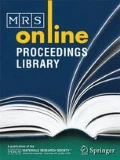Abstract
We have proposed the use of glass-like carbon (GC), as mold material because the 27-maximum etching selectivity of polysiloxane film against GC, which was approximately six times larger than that of polysiloxane film against chemical vapor deposited (CVD) diamond film. We have investigated the fabrication of diamond nanopit arrays by room-temperature curing nanoimprint lithography (RTC-NIL) using GC mold, as applications to the emitter and the micro-gear. The polysiloxane has in the state of sticky liquid at room-temperature and negative-exposure characteristic. Therefore, the polysiloxane was used as RTC-imprint resist material, and also used as electron beam (EB) resist (oxide mask) material in EB lithography. We have fabricated the cylindrical GC nanodot mold with 500 nm-diameter, 600 nm-height and 2 µm-pitch. We carried out RTC-NIL using GC mold under the following optimum conditions: time from spin-coating to imprint of 1 min, imprinting pressure of 0.5 MPa and imprinting time of 5 min. Then, we have processed the diamond film with an electron cyclotron resonance (ECR) oxygen ion shower. We have fabricated diamond nanopit array with 250 nm-depth and 500 nm-diameter. The diameter of diamond nanopit pattern was in good agreement with that of GC mold. Moreover, the depth of the diamond nanopit patterns fabricated by RTC-NIL using cylindrical GC mold was three times larger than that using conical diamond mold.
Similar content being viewed by others
References
K. D. Kim, J. H. Jeong, S. H. Park, D. G. Choi, J. H. Choi and E. S. Lee, Microelectron. Eng. 86, 1983 (2009).
S. W. Youn, M. Takahashi, H. Goto, R. Maeda, J. Mater. Process. Technol. 187, 326 (2007).
Y. Zhang, J. Lu, S. Shimano, H. Zhou, R. Maeda, Electrochem. Commun. 9, 1365 (2007).
S. W. Youn, M. Ogiwara, H. Goto, M. Takahashi and R. Maeda, J. Mater. Process. Technol. 202, 76 (2008).
N. Takazawa, T. Yamanoi, K. Iizuka, T. Hiraide, H. Yoshiawa, Y. Ando, M. Mita, H. Oi, M. Takahashi and M. Yoshimoto, Diamond Relat. Mater. 20, 866 (2011).
G. M. McClelland, M. W. Hart, C. T. Rettner, M. E. Best, K. R. Carter and B. D. Terris, Appl. Phys. Lett. 81, 1483 (2002).
S. Kiyohara, Y. Taguchi and H. Takikawa et al., in Diamond Nanopit Arrays Fabricated by Room-Temperature Nanoimprinting using Diamond Molds, edited by C. E. Nebel, P. Bergonzo and J. E. Butle, (Mater. Res. Symp. Proc. 1282, Boston, MA, 2010) pp. 117–122.
S. Kiyohara, T. Kashiwagi, H. Takikawa, Y. Kurashima, Y. Taguchi and Y Sugiyama, e-J.Surface Sci. and Nanotech. 7, 772 (2009).
Author information
Authors and Affiliations
Rights and permissions
About this article
Cite this article
Kiyohara, S., Ito, C., Ishikawa, I. et al. Fabrication of Diamond Nanopit arrays by Room-temperature Curing Nanoimprint Lithography Using Glass-like Carbon Molds. MRS Online Proceedings Library 1395, 27–32 (2012). https://doi.org/10.1557/opl.2012.9
Published:
Issue Date:
DOI: https://doi.org/10.1557/opl.2012.9



